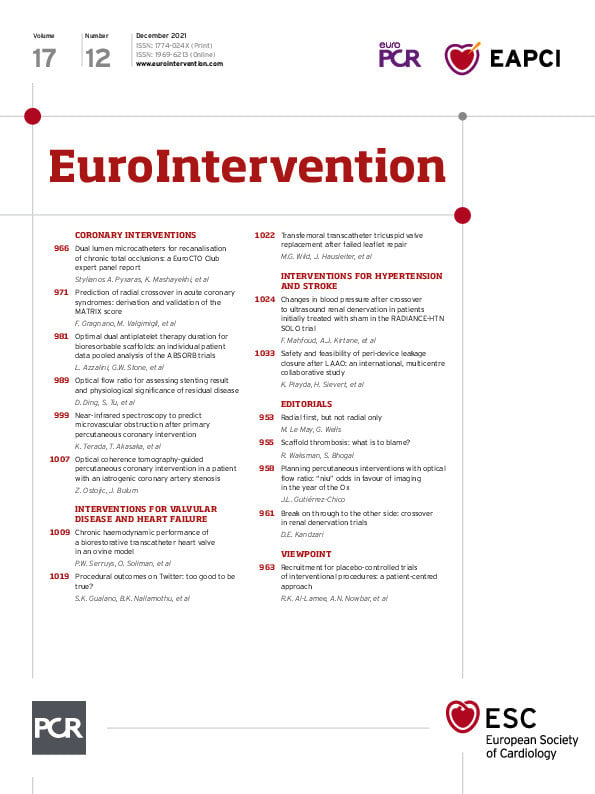Nearly a decade ago, Alberto Zanchetti, the former editor of the Journal of Hypertension, and colleagues, stated that over 245,000 patients included in 50 clinical trials were more than sufficient to conclude that what really matters is lowering blood pressure (BP), how BP is lowered is of minor importance1. Although intended as a reference to the varied classes of antihypertensive medications, could this statement now be expanded to include both drug- and device-based therapies? To date, five sham-controlled randomised trials have demonstrated clinically meaningful and statistically significant reductions in BP with renal denervation (RDN), both in the absence and presence of concomitant antihypertensive medications. Importantly, these achievements were realised following lessons learned from early miscalculations in trial design and conduct, procedural methods, and patient selection2. Although additional trials are ongoing, given the proven therapeutic potential of RDN, the focus has more recently shifted beyond proof of concept to issues relevant to clinical application, including durability and safety. To this end, crossover in blinded, randomised trials examining the effectiveness of RDN has special relevance.
In this issue of EuroIntervention, Mahfoud and colleagues3 report safety and effectiveness outcomes among subjects initially randomised to sham control in the RADIANCE-HTN SOLO trial, who then later crossed over to ultrasound RDN2. Among the 72 patients in the initial sham cohort, 33 participants underwent ultrasound RDN after an average follow-up period of two years. The most common reasons for not receiving treatment included not fulfilling crossover criteria and patient/physician preferences. Initially, individuals with uncontrolled BP not taking medications were enrolled. Antihypertensive therapies were then prescribed for all patients with persistent hypertension following verification of the primary endpoint at two months. Unlike the initial RDN group treated in the absence of medication, following the anti-hypertensive therapy reinstatement in the crossover group, the average number of medications per patient was 1.2±0.8, and the mean daytime ambulatory systolic BP was 144.1±10.1 mmHg. At six months, the mean change in daytime ambulatory systolic BP was –10.8±17.3 mmHg, with no change in the number of antihypertensive medications. Although significant reductions in 24-hour systolic and diastolic ambulatory BP measures were also observed, the absolute reductions in office systolic BP were modest and did not statistically differ from the crossover timepoint to six months. No major device-related adverse events were observed.
In part intended to encourage enrolment given the uncertainty of treatment status in randomised RDN trials, the opportunity for control subjects to crossover to active therapy following unblinding offers additional advantages. Increasing the number of treated subjects improves the trial's efficiency with more precision regarding safety estimates. Incremental information is also provided regarding efficacy in a study cohort with characteristics similar to those initially treated at randomisation. Unlike randomised comparisons, the study participants may also serve as their own control following crossover.
In most RDN trials, crossover is permitted following demonstration of effectiveness and unblinding. However, conditions permitting crossover vary among RDN protocols. Specifically, studies differ on whether subjects must re-qualify regarding BP, medication criteria and the timing of crossovers. As crossover is not mandatory, physician discretion and patient preference introduce bias as well. An additional limitation common to crossover studies is a “carry over” effect from the previous intervention to the next, thereby influencing the results3. That is, the effect might not be due to the treatment itself, but may also be due to the interactions between the treatment and the study period/sequence. To this point, the treatment given as part of crossover in the current study differs from that at the time of randomisation in that patients were both unblinded and prescribed BP-lowering medications. In prior unblinded RDN studies, as in this analysis, treatment effects have been consistently greater than those observed in sham-controlled, randomised trials—including those results from the on-medication RADIANCE-HTN TRIO trial. Adding to the uncertainty, although crossover subjects were not required to re-qualify when off-medication, their daytime ambulatory systolic BP measures were highest at the time of crossover (~10 mmHg greater) than at all prior timepoints since medication reinstatement. Indeed, pre-crossover BP measures at 6- and 12-month assessments were closer to the 2- and 6-month post-treatment results. While these highest BP values at the time of their eligibility assessment may be attributed to a "big day bias", it was observed that the medication burden was somewhat lower at the time of crossover than at prior 6- and 12-month follow-up assessments. This implies the possibility that prescriber and/or patient behaviours may have influenced eligibility for crossover. Finally, unlike the initial study period, assays for adherence to drug therapy at the time of BP assessments for crossover patients were not performed. However, if awareness of RDN treatment led to greater medication nonadherence, this might instead bias the result towards a null effect.
Despite all the potential challenges of interpreting crossover results in RDN trials, the conclusion remains that BP is safely and effectively reduced with this therapy. Equally important, the crossover experience highlights the confounding variables that persistently challenge the long-term assessment of RDN. For example, regarding the durability and responder analyses, single point comparisons and methods of BP assessment may not appropriately characterise a treatment response to RDN therapy. As seen in the present study, no difference in office BP was identified at six months despite a clinically significant reduction in ambulatory BP. As with unblinding in the SYMPLICITY HTN-3 trial, the current crossover experience is a reminder that patient awareness of treatment status unpredictably influences behaviours related to medication adherence and lifestyle. Just as a new generation of randomised trials have established the benefit of RDN for the treatment of hypertension, unblinded studies representative of real-world practice will offer another level of understanding for RDN’s role among existing standards of care.
Conflict of interest statement
D.E. Kandzari reports institutional research and grant support from Medtronic and Ablative Solutions, and personal consulting honoraria from Medtronic.
Supplementary data
To read the full content of this article, please download the PDF.

